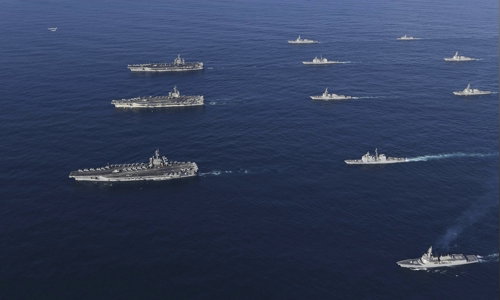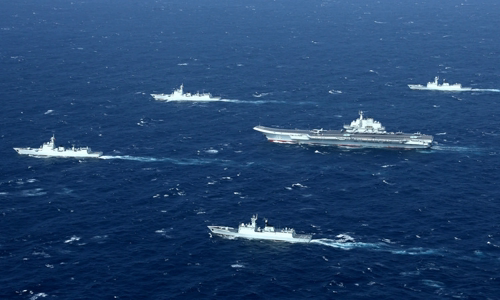Aircraft carriers are expensive and vulnerable, but are still favored by naval powers to show military power.
The aircraft carrier was originally designed to serve as air defense for fleets at sea, but this role changed completely during World War II, when its airships became the spearhead of the attack. naval forces of all countries in confrontations at sea.

Three groups of US aircraft carriers showed strength near the Korean peninsula in late 2017 Photo: US Navy
This role gradually faded after World War II, when the Soviet Union, America's main rival during the Cold War, was not entirely a naval power. Nonetheless, the United States continues to develop a fleet of aircraft carriers to ensure its mastery of the sky on all fronts.
The US combat doctrine requires its navy to maintain 11 super aircraft carriers, allowing Washington to deploy military power at a level no other country can. Many military powers have also tried to build aircraft carriers, though their size and capability are far behind those of US super carriers.
He built two super-class Queen Elizabeth-class aircraft carriers, China plans to have at least six of them by 2035, and India has adopted an ambition to own three aircraft carriers. The Russian Navy tried to repair Admiral Kuznetsov repeatedly having trouble to bring it back to service soon, while Japan has just announced plans to convert two Izumo-class battleships into full aircraft carriers.
This trend is happening in the context that aircraft carriers are increasingly faced with many threats, especially from submarines and anti-ship missiles. In order to ensure safety against shore-based anti-ship missiles with greater range, carriers are increasingly operating offshore, reducing their usefulness.
"The heart of the American fleet is in danger of falling into the footsteps of battleships that have been replaced by them. It is expensive, bulky, vulnerable, no longer suitable for current and similar conflicts." ", retired navy colonel Jerry Hendrix admitted.
The super-aircraft carrier USS Gerald R. Ford, worth $ 13 billion, became the most expensive battleship in the world history when commissioned in 2017. This amount is equal to two-thirds of Iran's defense budget in 2018. and double the cost of manufacturing USS George HW Bush, the last of the Nimitz-class super aircraft carriers.
Each Nitmitz-class aircraft carrier has a crew of more than 6,000, double the size of the Danish navy. The annual operating and maintenance cost of a Nimitz is $ 726 million, not to mention the $ 3-5 billion to buy dozens of aircraft for the airship on board and the budget of $ 1.8 billion / year to Guaranteed operation for them.
Even smaller aircraft carriers make up a large part of national defense budgets. USS Gerald R. Ford accounts for less than 2% of US military expenses, while this figure is 15% for the HMS Queen Elizabeth on the British payroll.
General David Richards, British Army chief of staff for the period 2010-2013, once urged London to cancel the project to close HMS Prince of Wales, the next HMS Queen Elizabeth. "We can build five state-of-the-art missile defense vessels at the same price," said General Richards, referring to a unit worth more than $ 5 billion for the Prince of Wales.
These statistics do not include the operating costs of aircraft carrier escort forces including cruisers, destroyers, escorts and submarines.
An aircraft carrier is expensive but very vulnerable to conflict between powers. A Chinese Type-039 diesel-electric submarine once stalked the aircraft carrier USS Kitty Hawk in the East China Sea without being detected until it actively emerged less than 8 km from the American aircraft carrier.

Liaoning carrier combatant group trains in the Pacific in 2018 Photo: SCMP
"Such close access during wartime will be much harder, as the U.S. aircraft carrier group will raise its guard. However, Beijing is significantly increasing its submarine attack capacity to respond," author Michael Houtz said. write in the Economist.
Analysis by the US-based RAND Research Institute shows that the "chance of attack", that is, the number of times Chinese submarines can enter an aircraft carrier position within 7 days, has increased tenfold in 1996-2010 period.
Submarines are not the only threat to aircraft carriers today. Russia and China are at the forefront of developing missiles such as "carrier assassins", which can be launched from the ground, aircraft, submarines or surface ships.
Moscow focuses on supersonic and subsonic cruise missiles with ranges from hundreds to thousands of kilometers, while Beijing pursues anti-ship ballistic missile projects with a range of 1,500 km, such as the DF-21D. "China can build 1,200 DF-21D at the cost of an American aircraft carrier," commented Colonel Hendrix.
Research by the Center for Strategic and Budget Assessment of America (CSBA) shows that US aircraft carriers must operate more than 1,900 km from the coast if confronting "rivals" such as China. Each ship is at risk of receiving 2,000 warheads of various types if it comes closer.
Despite this, naval powers are determined to invest in aircraft carriers, as they are not yet obsolete in modern warfare. "Many 'carrier killer' technologies have yet to prove practical, and the ability to track and track aircraft carriers is currently very limited," said Nick Childs, a naval expert at the Research Institute. International Strategy (IISS) in the UK, review.
The aircraft carrier remains consistent in conflicts with countries that are militarily inferior. Submarines and surface ships take over enemy missiles with cruise missiles, while the crew on the ship is responsible for long-range defense, airspace control, reconnaissance, attack effectiveness and support. ground.
"Aircraft carrier embodies military power, showing that the country owns is a naval power and also expresses their will in a certain area," said military expert Michael Koffman in Russia. opinion.
"Beijing probably best understands gunboat diplomacy by aircraft carrier," Houtz added. In 1996, the Chinese mainland army conducted a large-scale exercise, launching multiple missiles toward the Taiwan Strait when islanders directly elected the head of government for the first time.
The United States quickly responded when sending two carrier groups close to the island of Taiwan and warned of "serious consequences" if Beijing used military means to attack the island. China realized that it had no weapons to suppress American aircraft carriers, though they operated not far from the coast and admitted that Washington could not be prevented from supporting Taipei when the conflict broke out.
The event made Chinese political and military leaders realize that they will always be "under the sea" in large seas without an aircraft carrier to oppose the US dominance. That pushed Beijing to reform and modernize the navy drastically to close the gap with Washington.



 PhoTartee
PhoTartee







